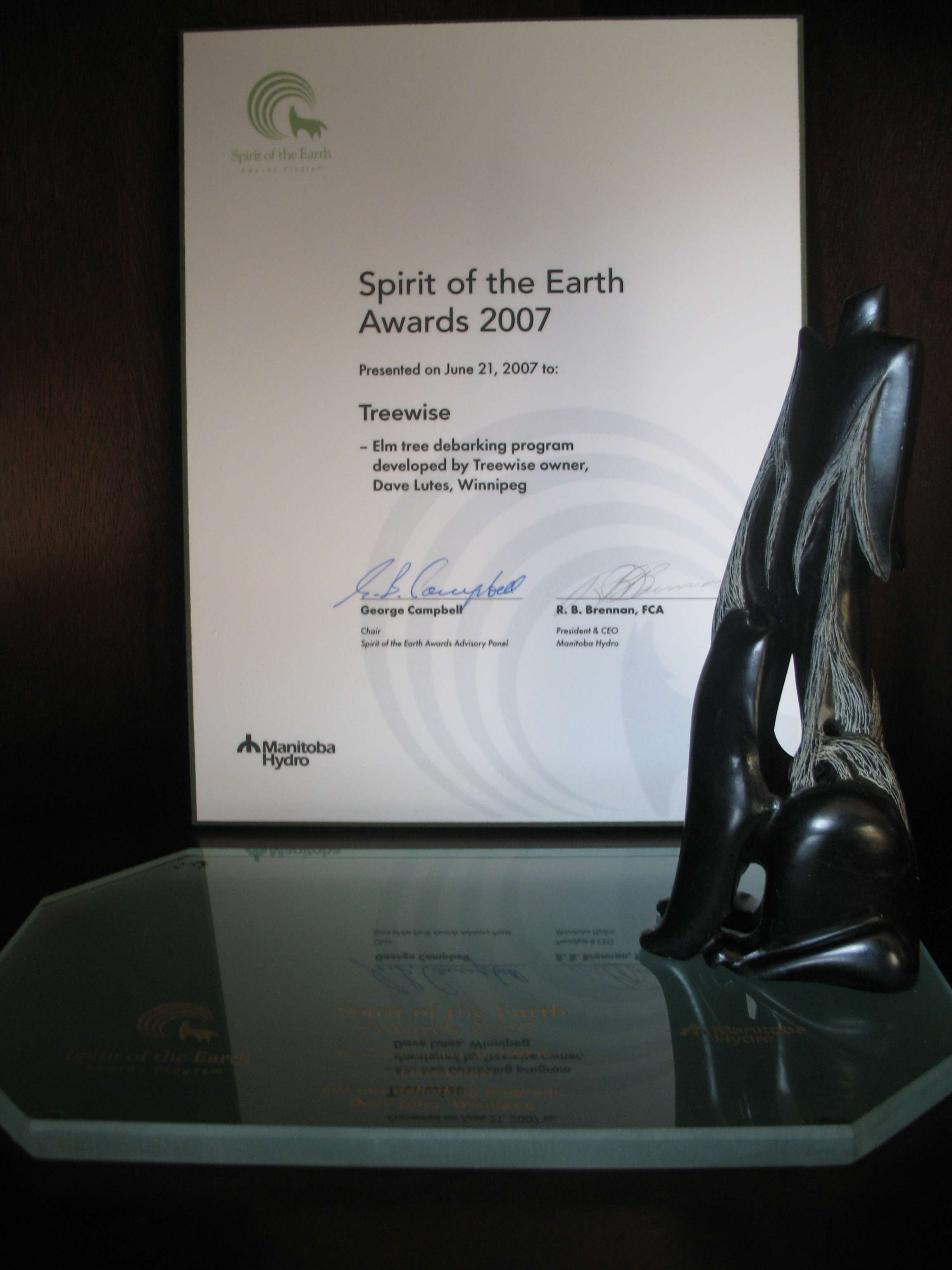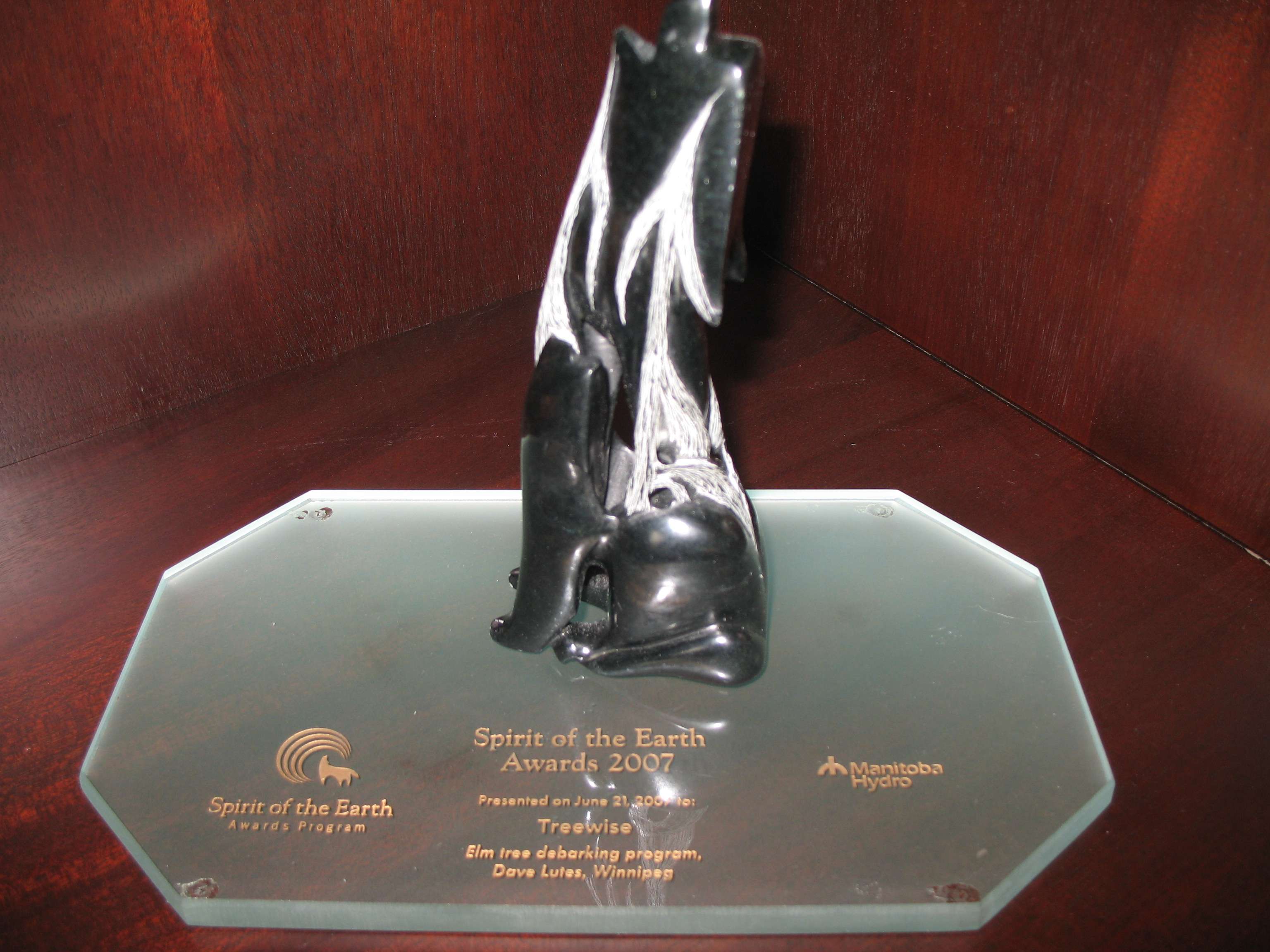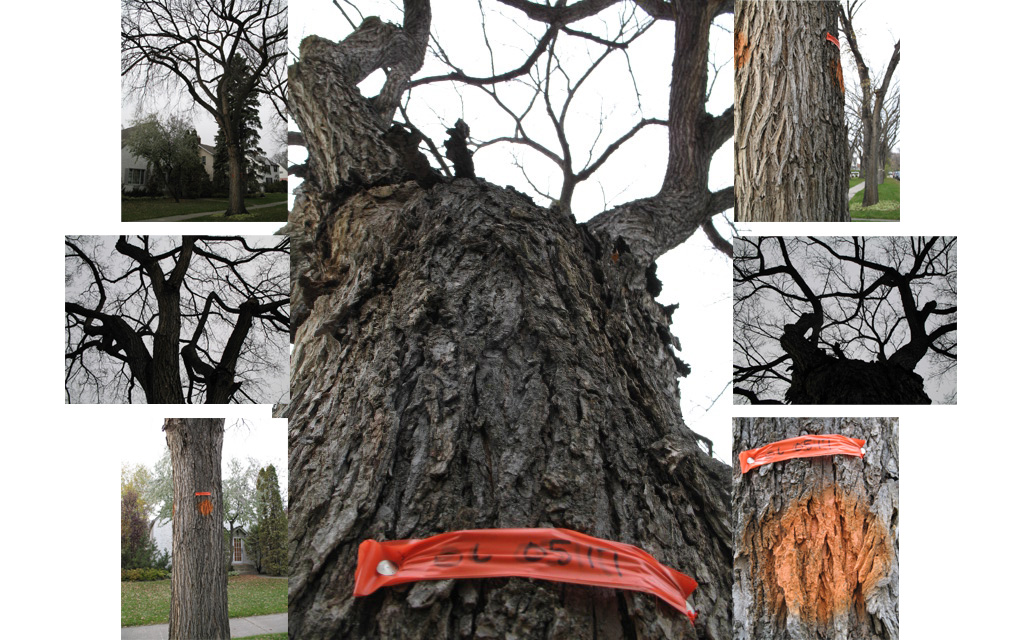
|
An End Befitting a DED-Elm
Treewise Wins Award
In 2007, Treewise received the Spirit of the Earth Award from Manitoba Hydro for Dave's environmental approach to harvesting wood from trees infected with Dutch Elm Disease (DED) - trees that would otherwise go to the landfill. This award is presented to an aboriginal-owned company.
 |
 |
What is DED?
Dutch Elm Disease (DED) is a fungal disease that blocks water movement in elm trees and eventually leads to death of the entire tree. The native American Elm is most susceptible to DED. A tree that has DED may produce small sparse leaves in spring, and in early summer, there will be a sudden wilting of leaves, usually at the top of the tree. Leaves curl and turn brown but don't fall from the tree. In late summer, leaves may become yellow and fall prematurely. Symptoms can spread quickly throughout the tree. Infected branches often show a brown stain on the wood, which can be seen by peeling back the bark. Young, vigorous growing trees can be killed in a few weeks, whereas larger, slower growing trees can take one to two years.
A dead or dying elm attracts elm bark beetles, which breed underneath the bark of the tree. Beetles emerging from trees killed by DED are contaminated with the spores of the DED-fungus. When these infected beetles mature and move to other elms to feed or spend the winter, they continue the infection cycle. The adult beetles are tiny, dark brown, and not easily visible to the naked eye (actual size of 2-3 mm). *
When are DED-Elms Removed?
In order to inhibit the spread of DED, DED-infected trees are removed while the elm bark beetle that carries the DED-fungus, lies dormant. This occurs between September 1st and March 15th each year.
Debarking
Because the elm bark beetle lives between the bark and the wood of a DED-infected elm, the Manitoba Provincial Government has legislated disposal policies for DED-elms **. In the past, companies contracted to remove DED-elms have chosen the least time-consuming and easiest of these legislated disposal-options: bury, burn, or haul to a landfill, all portions of an elm which includes valuable elm wood with its bark left on. The result: Tonnes of elm wood have been sacrificed. When Treewise performs DED-elm removals we remove a DED-elm's bark at the jobsite and reclaim the elm wood. This approach adheres to legislation because at the completion of a DED-elm removal, no elm wood remains with its bark on.
Debarking, as it is called, is what builders do to prepare trees for log-homes. Debarking is also done by sawyers and sawmill operators to lessen the wear-and-tear on their equipment. It's a practice that is appropriate for many sections of a mature elm. It takes time to perform but it leads to an end befitting an elm tree - a tree that has graced Winnipeg neighborhoods for a century or more.
Because a DED-elm is typically between 15 and 150 years old, various milestones will have been reached in Winnipeg during a DED-elm's lifetime:
|
Between 2,500 and 7,000 elm trees are removed annually as part of the City of Winnipeg's DED-program. Treewise's approach to DED-disposal supports The City of Winnipeg's commitment to developing partnerships to enhance DED-programs and procedures. ***
* Manitoba Conservation, Forestry Branch website ** Manitoba Conservation, Forestry Branch website: Legislation governing the disposal of DED trees *** City of Winnipeg Public Works website
Uses for Elm Wood
Dave removes the bark from elm wood that is too large to go through a chipping-machine. After the bark is removed, Dave either cuts the wood into firewood or into large slabs/planks depending on its size. Any beetles that may remain in a DED-elm are dormant during DED-removal season and will not survive once the bark is removed from the elm wood.
Dave cuts the smaller pieces of debarked wood into firewood. Elm firewood is one of the best woods to burn due to its high-BTU. Elm wood is similar to oak in this respect. All indoor and outdoor wood-burning furnaces would benefit from elm in their systems. Debarked elm firewood can be safely stored without concern for creating a habitat for the elm bark beetles that carry the DED-fungus. In contrast, when the bark is left intact, elm firewood is not usable due to the restrictions on its storage. Because DED-elms contracted to Treewise to remove are quite dead, debarked elm firewood can often be burned without having to sit as long to dry.
 |
 |
The bark, once separated from the elm wood, is chipped along with any of the branches that aren't suitable for firewood. (If an outdoor firepit is available, the bark may be burned because it makes an excellent firestarter.) Treewise uses specialized chipping equipment to chew up the elm branches and turn them into wood chips that are hauled offsite.
 |
 |
Dave cuts the larger pieces of debarked wood into slabs or planks. He may also slice circles of wood that are charming when placed in a foot-path or finely-sanded for use as a table-top. Elm wood has a beautiful grain that can be used to build fine furniture and specialty wood products. Again, it's similar to oak in this respect. When you consider that a board-foot of wood (1' thick, 1-foot square), sells for between $6 and $15, elm wood offers real value to either the hobbyist or professional furniture-maker. We know how difficult it is to find solid-wood furniture; with the emergence of DED, solid wood furniture made with elm became impossible to find except as rare, expensive antiques. Now that Treewise is saving elm wood, it can once again be used for shelves, tables, chairs, benches, cupboards, armoires, bowls, craft-items with unique and interesting shapes and configurations, and so on.
 |
 |
 |
 Dave made this bench using his chainsaw (ie. no subsequent planing or sanding was done to fine-tune the product.) That's birdseed on top sprinkled by the homeowner. Dave made this bench using his chainsaw (ie. no subsequent planing or sanding was done to fine-tune the product.) That's birdseed on top sprinkled by the homeowner. |
Here we see an elm in its final stages of removal. The ice-tea bottle offers a sense of the size of the elm (approximately 88 cm in diameter and 60 feet tall), that once commanded this back-yard. The tree's removal is a loss for the entire neighborhood - no more shade, no more sound-barrier, no more privacy offered. But we can acknowledge the departed elm's contribution to our community and our city by using its wood. The slabs of wood with their striking grain will make attractive, functional furniture to be handed down through generations, and the firewood will warm homes/garages to save on heating costs and lower our reliance on gas and oil.
 |
 |
 |
|
Goodbye, Old Friend

If you are interested in obtaining elm firewood or slabs/planks of elm, or if you have feedback on our efforts, please call us at (204) 777-2007. We're always looking for novel ways to utilize elm wood so if you have any ideas, we'd like to hear from you!
Treewise will also prepare firewood and slabs/planks of wood from other tree varieties. Any inquiries are welcome.
